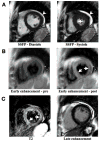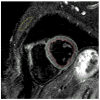Cardiovascular magnetic resonance in myocarditis: A JACC White Paper
- PMID: 19389557
- PMCID: PMC2743893
- DOI: 10.1016/j.jacc.2009.02.007
Cardiovascular magnetic resonance in myocarditis: A JACC White Paper
Abstract
Cardiovascular magnetic resonance (CMR) has become the primary tool for noninvasive assessment of myocardial inflammation in patients with suspected myocarditis. The International Consensus Group on CMR Diagnosis of Myocarditis was founded in 2006 to achieve consensus among CMR experts and develop recommendations on the current state-of-the-art use of CMR for myocarditis. The recommendations include indications for CMR in patients with suspected myocarditis, CMR protocol standards, terminology for reporting CMR findings, and diagnostic CMR criteria for myocarditis (i.e., "Lake Louise Criteria").
Conflict of interest statement
There are no severe potential conflicts of interest.
Figures



References
-
- Doolan A, Langlois N, Semsarian C. Causes of sudden cardiac death in young Australians. Med J Aust. 2004;180:110–2. - PubMed
-
- Puranik R, Chow CK, Duflou JA, Kilborn MJ, McGuire MA. Sudden death in the young. Heart Rhythm. 2005;2:1277–82. - PubMed
-
- Virmani R, Burke AP, Farb A. Sudden cardiac death. Cardiovasc Pathol. 2001;10:211–8. - PubMed
-
- Kawai C. From myocarditis to cardiomyopathy: mechanisms of inflammation and cell death: learning from the past for the future. Circulation. 1999;99:1091–100. - PubMed
Publication types
MeSH terms
Grants and funding
LinkOut - more resources
Full Text Sources
Other Literature Sources
Medical

